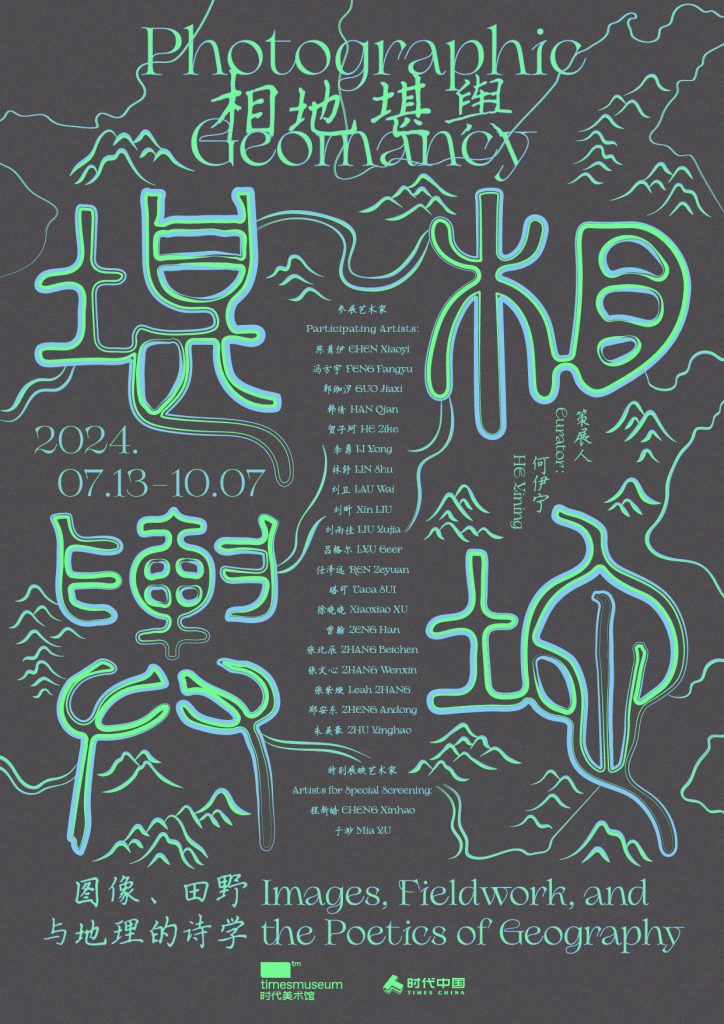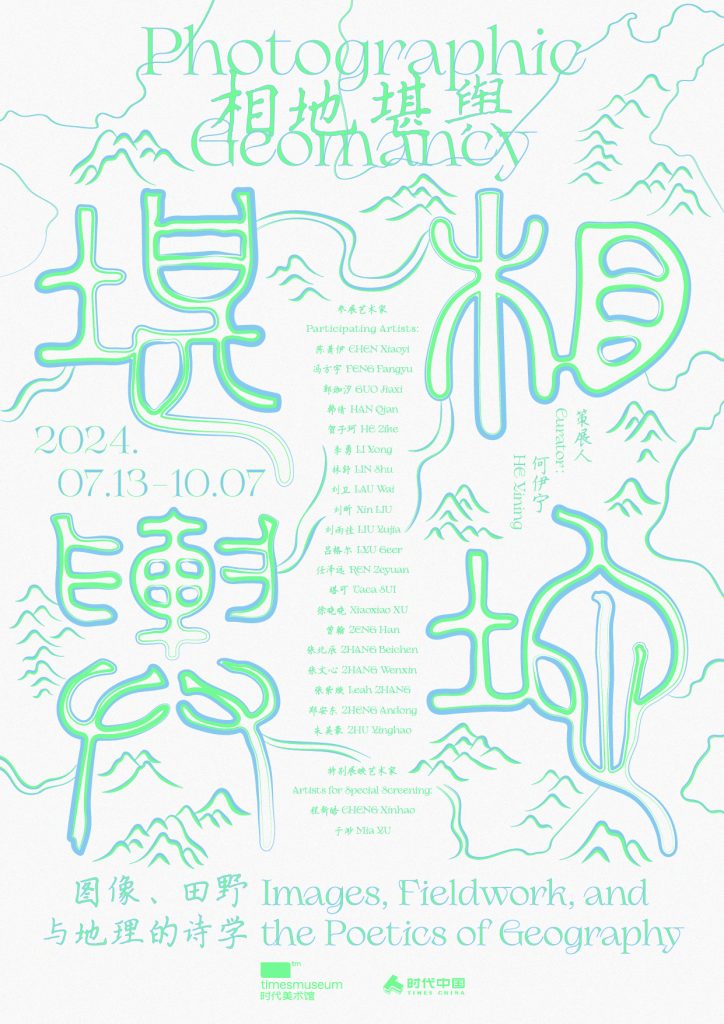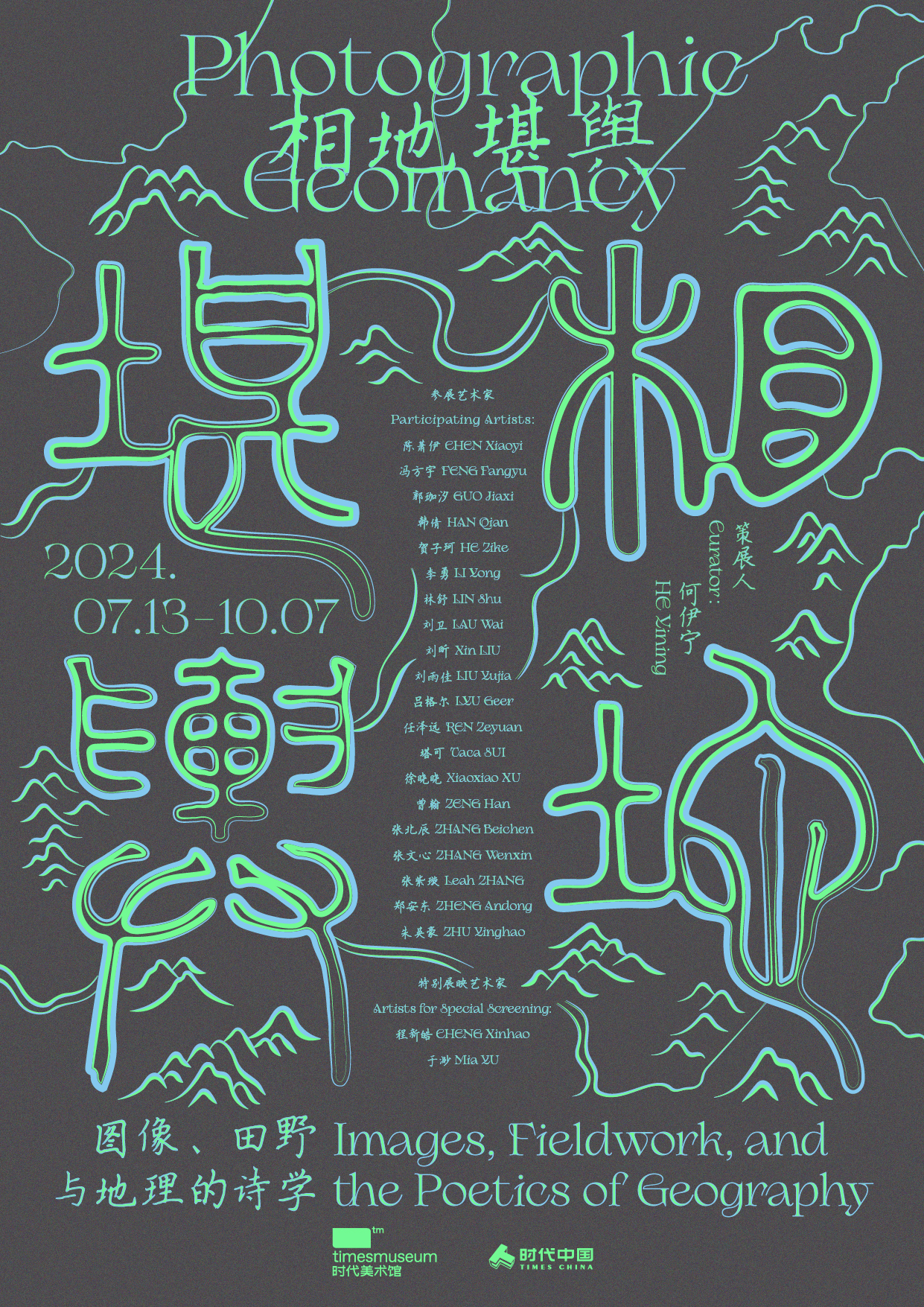Photographic Geomancy: Images, Fieldwork, and the Poetics of Geography

12 Jul → 7 Oct 2024
Participating Artists
Chen Xiaoyi Feng Fangyu Guo Jiaxi Han Qian He Zike Li Yong Lin Shu Lau Wai Xin Liu Liu Yujia Lyu Geer Ren Zeyuan Taca Sui Xiaoxiao Xu Zeng Han Zhang Beichen Zhang Wenxin Leah Zhang Zheng Andong Zhu Yinghao
Artists for Special Screening
Curator
Venue
Guangdong Times Museum
The “Photographic Geomancy” exhibition investigates the intricate relationships between Chinese contemporary art practices, indigenous geographical knowledge, global ecological discourse, and artists’ embodied field experiences. This research-based exhibition showcases works by 22 artists who employ photography and video as their primary mediums to reconstruct visual narratives through geographical lens. Using “geomancy” as a conceptual framework, the exhibition demonstrates how artists respond to complex aesthetic, cultural, ecological, and geopolitical issues inherent in Chinese geography through fieldwork methodologies.
The exhibition is structured into four interconnected sections, organized around the thematic content and critical issues explored in the artists’ works:
“Retracing Ancient Terrain” explores the convergence of traditional Chinese cultural aesthetics and geography through photographic practice. Works by Guo Jiaxi, Lin Shu, Taca Sui, Zeng Han, and Xiaoxiao Xu reveal the inherent beauty of Ling Mountain, enigmatic Buddhist pagodas, the spatial significance of caverns, the essence of historic landscape paintings, and the complex nature of the Great Wall. This section emphasizes photography’s documentary and introspective value.
“Geological Perception” features works by Chen Xiaoyi, He Zike, Li Yong, Zhang Wenxin, and Leah Zhang that examine the interconnectedness of geology and ecology across diverse locations including the Hengduan Mountains, Guizhou Plain, Fushun Mining Area, underground caves, and iron mines. These works reveal the profound connection between humans and the earth, demonstrating how contemporary art reflects on the relationship between nature and humanity.
“Infrastructure Archaeology” investigates infrastructure development across water conservancy, communication, industry, mining, and urban spaces. Works by Lyu Geer, Zhang Beichen, Feng Fangyu, Han Qian, and Lau Wai illuminate the complex relationship between modernity and geopolitics.
The concluding section, “Poems of Phantom Lands,” presents artistic creations by Zhu Yinghao, Zheng Andong, Liu Yujia, Xin Liu, and Ren Zeyuan. This section transports audiences to fictional rural realms that transcend temporal and spatial constraints, continuously investigating the intricate relationships between humanity and nature, as well as the interplay between technology and ecology.
The exhibition design translates these narratives into four distinct spatial experiences: “Mountain Walking,” “Exploring the Territory,” “Entering the City,” and “Returning Home.” It invites audiences to explore China’s mountains, rivers, and historical dimensions by following the artists’ journeys. The exhibition aims to reinterpret the expansive Chinese landscape through the synthesis of visual art, geography, and history. The program will include artist screenings, academic roundtables, artist workshops, and public education initiatives.
相地堪舆:图像、田野与地理的诗学

2024年7月12日 → 10月7日
参展艺术家
陈萧伊 冯方宇 郭珈汐 韩倩 贺子珂 李勇 林舒 刘卫 刘昕 刘雨佳 吕格尔 任泽远 塔可 徐晓晓 曾翰 张北辰 张文心 张紫璇 郑安东 朱英豪
特别展映艺术家
策展人
主办方
“相地堪舆”展览考察了中国当下艺术实践与本土地理知识、全球生态话语,以及艺术家个体经验之间的联系。这一研究型展览呈现了22位艺术家利用摄影和影像作为主要创作媒介,重新构建与地理相关的视觉叙事。展览以“堪舆学”作为隐喻,展现出艺术家通过校察地理的方法,回应与华夏大地相关的美学、文化、生态与地缘等复杂议题。
展览基于艺术家实践的内容和主题,共分为四个相互缠绕的板块。在“坤舆寻址”中,郭珈汐、 林舒、塔可、曾翰与徐晓晓借助摄影探索中国传统文化和美学与地理的交汇处,呈现灵山的 自然与人文、佛塔的神秘、洞天的时空意涵,古代山水画精神以及长城的多面性,揭示摄影 的记录与反思价值。在“地质感知”中,陈萧伊、贺子珂、李勇、张文心与张紫璇的作品连接 起横断山脉、贵州平原、抚顺矿区、地下洞穴和铁矿的地质与生态话语,揭示了人类与大地 的深刻联系,展现了当代艺术对自然与人类关系的反思。
在“基建考古”中,吕格尔、张北辰、 冯方宇、韩倩和刘卫的作品在水利、通信、工业、矿业和城市空间等基础设施建设中穿行, 揭示了现代性与地缘政治的复杂关系。在此之上,最后一个章节“幻乡诗章”透过朱英豪、郑安东、刘雨佳、刘昕,以及任泽远的作品,带领观众进入一个跨越时空的幻乡,持续探索人类与自然、科技与生态之间的复杂关系。
“相地堪舆”的展览设计按照四个章节的线索塑造出“行山”、“探境”、“入城”与“归乡”的动线,邀请观众“穿梭”于华夏大地的山川、河流与人文历史之间,跟随艺术家的旅程,在视觉艺术、地理与历史的交叉之处重新认识广袤的华夏地理。展览期间将举办包括艺术家展映、学术圆桌、艺术家工作坊,以及相关的公共教育活动。

Reply